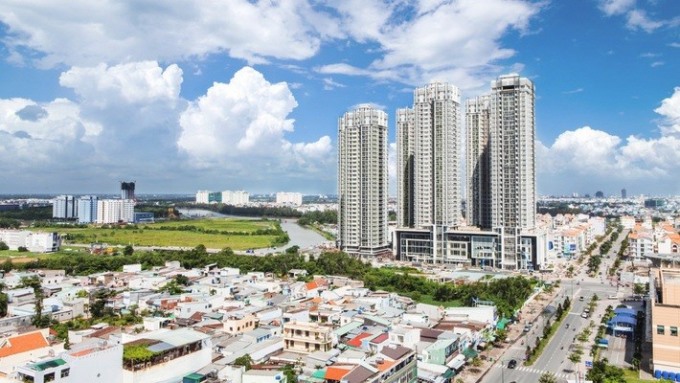 Business Beat
Business Beat

Chu Anh Tuấn, deputy general director of property developer Hà Đô Group, said recently his company expects consolidated profit after tax to be VNĐ700 billion (over US$30.43 million) this year.
 |
| Market observers said property companies’caution was due to many reasons, including the instability in the sector.— Photo phapluatplus.vn |
Chu Anh Tuấn, deputy general director of property developer Hà Đô Group, said recently his company expects consolidated profit after tax to be VNĐ700 billion (over US$30.43 million) this year.
But its target for next year is only VNĐ800 billion ($34.9 million), a 15 per cent year-on-year increase, he said.
The Development Investment Construction Joint Stock Corporation (DIG)’s leadership has also been very cautious in setting business targets for next year.
A company spokesperson said the growth target for 2019 would only be 10 per cent higher than for this year.
The targets are rather modest when seen against the real estate industry’s performance this year. In the first nine months the profits of many enterprises grew by more than 100 per cent year-on-year.
DIG for instance reported VNĐ178.6 billion in pre-tax profit, 167 per cent up.
Asked about his company’s modest profit target for 2019, a Hà Đô spokesman said it would be very difficult for not only the real estate sector but also others to sustain high growth rates year after year.
Besides, the sector’s growth peaked in 2017-18 period and so this success would not be easy to replicate in the coming years, especially in 2019.
Market observers said property companies’caution was due to many reasons, including the instability in the sector.
There is a supply-demand imbalance, especially in the high-end, tourism and resort property segments, they warned.
The number of transactions in the first six months of this year fell sharply yet the number of developments and supply has continued to increase, causing an oversupply, particularly in the high-end segment, they said.
In 2015-18, a significant number of high-end projects have been developed by well-known names creating the imbalance, they explained.
They cited the example of HCMC where 65 projects brought 23,756 houses into the market, including 22,684 apartments.
Luxury units accounted for 31.3 per cent, mid-priced ones for 49.4 per cent, and low-end ones for only 19.3 per cent.
Meanwhile, demand for cheap apartments was highest.
A representative of the Hồ Chí Minh City Real Estate Association (HoREA) said the city is facing a serious shortage of low-priced commercial apartments, social housing and particularly low-rent apartments for workers and low income earners.
This would create instability in the market and society, he warned.
Another cause of instability is the “land fever” occurring at many places around the country, with HoREA experts saying this involved mainly agricultural lands being illegally divided into plots and used for unauthorised purposes.
This was distorting the real estate market, they warned.
Real estate companies’ caution in setting growth targets for next year has also been due to fears of a possible real estate bubble.
Analysts said a bubble occurred 10 years ago and the industry is afraid the next one is due based on 10-year cycles.
Underlying risks
The real estate market began a recovery in 2014 after a bubble burst a few years earlier, and since then there has been an unprecedented supply of new projects and with a good net absorption rate.
Besides traditional products, many new ones too have been introduced, such as second-home villas, condotels and officetels. In 2015 the Government began to allow foreigners to buy and own properties in Việt Nam, and they have duly obliged.
Nonetheless, analysts and investors are wary of the pace of growth, and point to underlying risks.
They include an oversupply of high-end housing projects, the return of speculators and declining market demand.
Their biggest concern is the formation of a bubble like the one that burst in 2007 and kept the market in limbo until 2013. The market is still paying the price.
By next year people are sure to be on the lookout for the first worrying signs.
Võ Huỳnh Tuấn Kiệt, head of residential project marketing at CBRE Vietnam, spoke to Vietnam Investment Review (VIR) about the prospects of a bubble forming.
He listed the factors that contributed to the formation and bursting of the last bubble.
The first was the overheating of the economy: In 2007, Việt Nam’s GDP growth rate had reached 8.5 per cent, with HCMCity reporting a rate of 12.6 per cent, a decade high.
Needless to say incomes were rising tremendously. The stock market reached a historic high of 1170.67 points on March 12, 2007. A huge amount of money made its way into the housing market, which has always been a favoured asset class in Việt Nam.
Kiệt pointed to the easy credit policies then, saying that was a direct cause of the bubble.
In 2007, credit grew at more than 37 per cent, with a large amount of money pouring into real estate.
The lax control over credit and its use for inappropriate purposes brought the market down, Kiệt said.
The third reason Kiệt mentioned was the rampant speculation and secondary market boom, which saw relentless price increases and people buying to flip properties and real estate agents ruling the roost.
The final reason he said was lack of government control and a failure to adopt timely fiscal policies, which led to the quick formation and growth of the bubble.
How are things now? Are these factors still in play?
Based on the factors Kiệt listed, analysts said a bubble seems unlikely in 2019.
After the last one, the Government has put in place a number of policies to monitor the real estate market, they said.
In 2016, the State Bank of Việt Nam adjusted the loan ratio and increased the credit risk weightage for real estate loans to closely monitor and control capital flows into the property market. In 2018, regulating the market remains a priority on the Government’s agenda.
GDP growth is expected to be 6.5-6.7 per cent this year, in other words not in overheated territory.
Credit growth in 2018 is expected to be no more than 17 per cent, with the central bank sticking firmly to its policy of not increasing the credit quotas of many banks in the middle of the year.
In recent years property developers have been increasingly targeting the mid-priced segment.
This segment accounted for 58 per cent of new launches in HCM City last year and 62 per cent in Hà Nội. It also accounted for 56 per cent and 53 per cent of the units sold in the two cities, according to VIR.
Its growth topped 35 per cent, higher than the market average.
This is easing concerns over the earlier skew towards high-end products.
One of the main factors contributing to a property bubble is the large number of speculators.
According to CBRE, in 2007-08 half of all transactions were by short-term speculators. This drove housing prices out of control in the secondary market as properties were constantly flipped.
In 2017, however speculators’transactions have only accounted for 10-15 per cent of the total number and been mostly focused on certain areas.
The low level of speculation in recent years has helped decrease the risk of price bubbles.
Besides, the secondary market in the condominium sector has not been very active in 2015-17. In 2017 only a small number of good locations and good projects fetched premiums of 15-25 per cent above the primary market price.
The sluggish secondary market reduces the risk of a bubble.
Kiệt said the real estate market is now on a more sustainable growth path compared to the past, and a bubble, as feared by many, is not likely to occur in the short run.
Nevertheless, constant monitoring is important for making suitable policy tweaks since certain segments such as land and shophouses have indeed seen rapid growth in some areas, he said.
Such signals should not be ignored because they could have a significant impact on the market if not addressed properly, he said. — VNS




